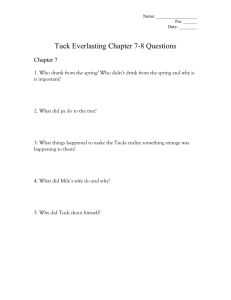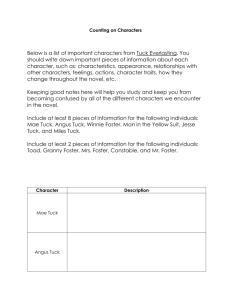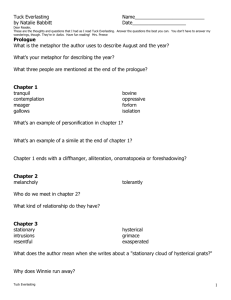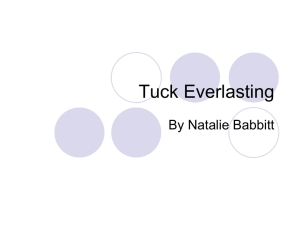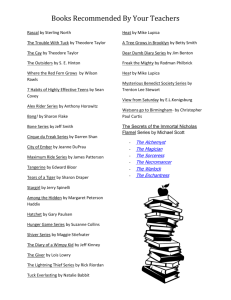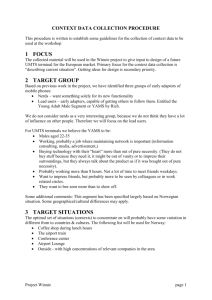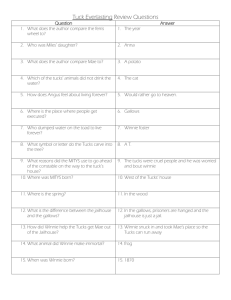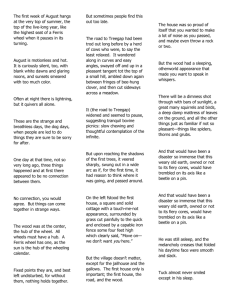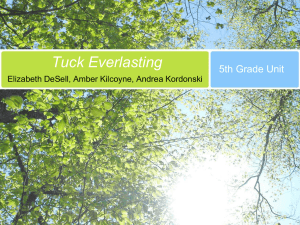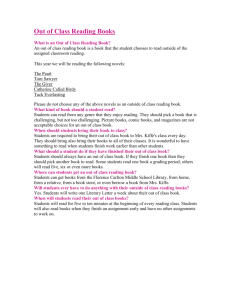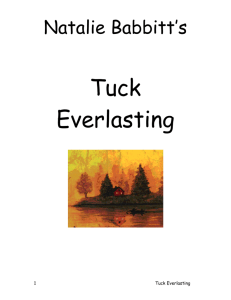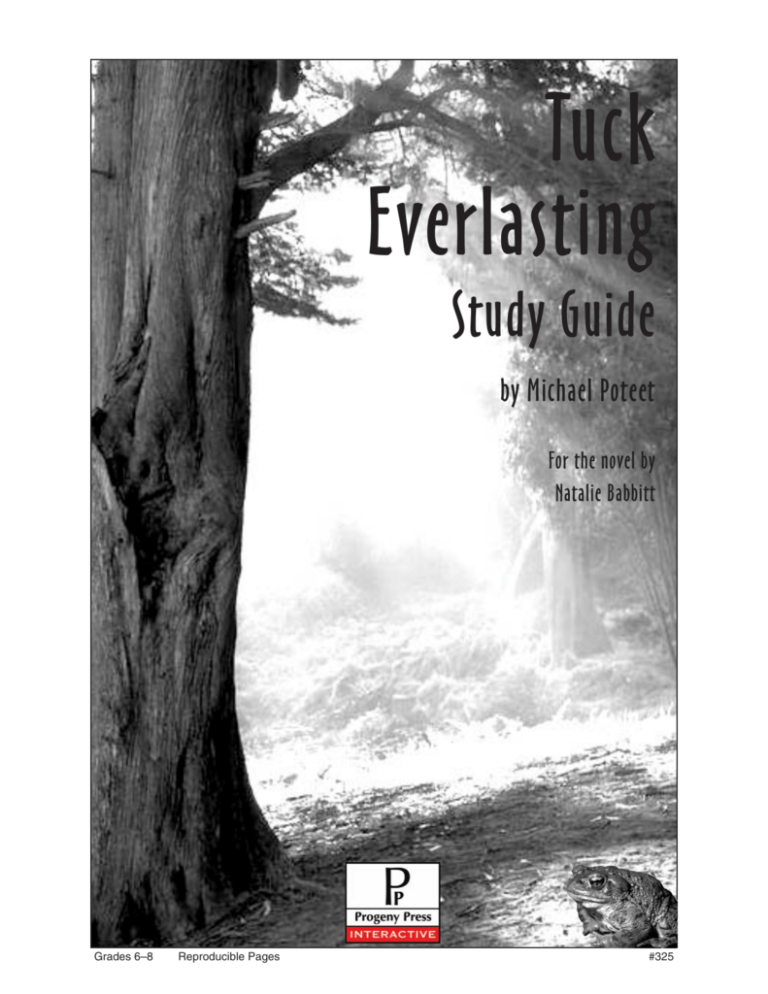
Tuck
Everlasting
Study Guide
by Michael Poteet
For the novel by
Natalie Babbitt
Grades 6–8
Reproducible Pages
#325
Limited permission to reproduce this study guide.
Purchase of this study guide entitles an individual teacher
to reproduce pages for use in the classroom or home.
Multiple teachers may not reproduce pages
from the same study guide.
This is a Progeny Press Interactive Study Guide. Sale of any copy or any form of this study guide,
except on an original Progeny Press CD with original sleeve, is strictly and specifically prohibited.
Tuck Everlasting Study Guide
A Progeny Press Study Guide
by Michael S. Poteet
edited by Andrew Clausen
Copyright © 2002 Progeny Press
All rights reserved.
Reproduction or translation of any part of this work
beyond that permitted by Section 107 or 108 of the
1976 United States Copyright Act without the written
permission of the copyright owner is unlawful.
Requests for permission or other information should be
addressed to Reprint Permissions, Progeny Press,
PO Box 100, Fall Creek, WI 54742-0100.
www.progenypress.com
Printed in the United States of America.
ISBN: 978-1-58609-354-9 Book
978-1-58609-273-3 CD
978-1-58609-446-1 Set
2
© 2002 Progeny Press
Tuck Everlasting Study Guide
Table of Contents
Study Guide Author .................................................................................................3
Peer Review Panel .....................................................................................................4
Note to Instructor .....................................................................................................6
Synopsis ....................................................................................................................7
About the Novel’s Author .........................................................................................8
Ideas for Prereading Activities .................................................................................10
Prologue–Chapter 5 ................................................................................................11
Chapters 6–10 ........................................................................................................20
Chapters 11–15 ......................................................................................................29
Chapters 16–20 ......................................................................................................33
Chapters 21–Epilogue ............................................................................................39
Word Search Review ...............................................................................................44
Overview ................................................................................................................46
Overview Activities .................................................................................................52
Related Resources ...................................................................................................54
Answer Key .............................................................................................................55
© 2002 Progeny Press
5
Tuck Everlasting Study Guide
Synopsis
Tired of living under the strict discipline of her parents and grandmother, 10-year-old
Winnie Foster decides to run away from home. She feels “cooped up” and wants to
make a difference in the world. When she ventures out on her own, she discovers a
young man in her family’s wood who belongs to a remarkable family with a remarkable claim: that the waters from a spring in the forest have given them immortality.
Mae Tuck, the family’s matriarch, kidnaps Winnie in order to keep this secret safe, but
a stranger in a yellow suit is already on the Tucks’ trail, eager to exploit their secret for
his own financial gain. Winnie must decide whether she believes the Tucks’ claim, if
she will trust and help them, and—before her adventures end—what kind of life she
will choose to live.
© 2002 Progeny Press
7
Tuck Everlasting Study Guide
Chapters 6–10
Vocabulary:
Define the underlined words from context and then check your definition against the
definition given in a standard dictionary.
1. . . . [Winnie] found herself straddling the bouncing back of the fat old horse . . .
while Mae ran puffing ahead, dragging on the bridle.
Your definition:
Dictionary definition:
2. Instead of crying out for help, she merely goggled at him as they fled past the
spot where he stood.
Your definition:
Dictionary definition:
3. “Oh, stuff,” said Jesse with a shrug. “We might as well enjoy it, long as we can’t
change it. You don’t have to be such a parson all the time.”
Your definition:
Dictionary definition:
4. The pastures, fields, and scrubby groves they crossed were vigorous with bees, . . .
Your definition:
Dictionary definition:
20
© 2002 Progeny Press
Tuck Everlasting Study Guide
5. But everything else was motionless, dry as a biscuit, on the brink of burning,
hoarding final reservoirs of sap, trying to hold out till the rain returned, . . .
Your definition:
Dictionary definition:
6. . . . it was as if they had slipped in under a giant colander. The late sun’s brilliance could penetrate only in scattered glimmers . . . .
Your definition:
Dictionary definition:
7. Under the pitiless double assaults of her mother and grandmother, the cottage
where she lived was always squeaking clean, mopped, and swept and scoured
into limp submission.
Your definition:
Dictionary definition:
8. The Foster women had made a fortress out of duty. Within it, they were
indomitable.
Your definition:
Dictionary definition:
9. . . . a cavernous oak wardrobe from which leaked the faint smell of camphor.
Your definition:
Dictionary definition:
© 2002 Progeny Press
21
Tuck Everlasting Study Guide
Similes and Metaphors:
Similes and metaphors are figures of speech that state or imply a comparison between
two unlike things that have something in common. A simile uses words such as like or
as to compare. One thing is said to be like another thing. A metaphor does not use
these comparison words. One thing is said to be another thing.
For example, the first two sentences in the book use both a simile and a
metaphor:
The first week of August hangs at the very top of summer, the top
of the live-long year, like the highest seat of a Ferris wheel when it
pauses in its turning. The weeks that come before are only a climb
from balmy spring, and those that follow a drop to the chill of
autumn.
The phrase “like the highest seat of a Ferris wheel” is a simile comparing the
first week of August to the highest seat on the Ferris wheel. This comparison is stated
directly, through the use of the word “like.”
The phrase “are only a climb from balmy spring” is a metaphor comparing the
preceding weeks to a climb. We know that dates on a calendar cannot have altitude, so
the comparison is implied by stating that these weeks are a climb, rather than saying
that they are like a climb.
Each of the following passages from Tuck Everlasting contains a metaphor or
simile. Put an M in the space after the sentence if the comparison is a metaphor or an S
if the comparison is a simile. Then write down the two things that are being compared.
1. The wood was at the center, the hub of the wheel. All wheels must have a hub.
____
____________________ is compared to ______________________
2. Mae sat there frowning, a great potato of a woman with a round, sensible face
and calm brown eyes. ____
____________________ is compared to ______________________
22
© 2002 Progeny Press
Tuck Everlasting Study Guide
3. [The toad] gave a heave of muscles and plopped its heavy mudball of a body a
few inches farther away from her. ____
____________________ is compared to ______________________
4. . . . though her heart was pounding and her backbone felt like a pipe full of
cold running water, her head was fiercely calm. ____
____________________ is compared to ______________________
5. Yes, it was the same music she had heard the night before. Somehow it calmed
her. It was like a ribbon tying her to familiar things. ____
____________________ is compared to ______________________
6. The sweet earth opened out its wide four corners to her like the petals of a
flower ready to be picked. ____
____________________ is compared to ______________________
7. Queen Anne’s lace lay dusty on the surface of the meadows like foam on a
painted sea. ____
____________________ is compared to ______________________
8. The Foster women had made a fortress out of duty. Within it they were
indomitable. ____
____________________ is compared to ______________________
9. . . . three armchairs and an elderly rocker stood about aimlessly, like strangers at
a party, ignoring each other. ____
____________________ is compared to ______________________
© 2002 Progeny Press
23
Tuck Everlasting Study Guide
Questions:
1. Why does Mae Tuck kidnap Winnie?
2. Who sees the Tucks kidnap Winnie? Speculate on what effect this might have.
3. What is revealed to be the source of the “elf music”?
4. What led the Tucks to realize the true nature of the spring they found?
5. What significant fact do we learn in the last paragraph of Chapter 8?
6. Although they kidnapped her, why does Winnie come to trust the Tucks and
consider them friends?
24
© 2002 Progeny Press
Tuck Everlasting Study Guide
7. What is Tuck’s reaction to meeting Winnie and finding out that she knows
their secret? Why do you think he reacts this way?
Thinking About the Story:
Comparing and Contrasting:
8. Read the description of the woods surrounding the Tucks’ cottage in the fourth
paragraph of Chapter 9. How does the description of these woods compare to
the description of the Fosters’ wood in Chapter 1?
9. Why might the author have chosen to describe these two locations in similar
terms?
10. Read the description of the Tucks’ cottage from Chapter 10. How does the
Tucks’ cottage contrast to the Fosters’ cottage?
11. How does this contrast highlight the differences in the two families?
© 2002 Progeny Press
25
Tuck Everlasting Study Guide
12. Winnie surveys the clutter of the Tucks home and thinks to herself: “Maybe it’s
because they think they have forever to clean it up.” The author writes that this
was followed by another thought “far more revolutionary”: “Maybe they just
don’t care.” Why would this be a revolutionary thought for Winnie?
Dig Deeper:
13. In Chapter 8, the author writes,
Closing the gate on her oldest fears as she had closed the gate of
her own fenced yard, [Winnie] discovered the wings she’d always
wished she had. And all at once she was elated. Where were the
terrors she’d been told she should expect? She could not recognize
them anywhere.
What are some fears about life or the world that you used to have that you have
since “closed the gate” on? How did you overcome those fears?
14. What fears have you not yet “closed the gate” on?
15. Read Psalm 46. What promise may be found in this Psalm for the times we are
afraid?
26
© 2002 Progeny Press
Tuck Everlasting Study Guide
16. When Mae leaves for Treegap in Chapter 1, she asks Tuck, “Will you be all
right?” Tuck replies, “What in the world could possibly happen to me?”
Practically speaking, what would the Tucks ever have to worry about or
fear?
17. What limits or boundaries would there be on people like the Tucks who could
live forever?
18. According to Jesse, Tuck speculates that the spring is “something left over from . . .
some other plan for the way the world should be.” What do you think he means?
19. Read Genesis 2:4–3:24. Based on these verses, what do you think God wanted
the world to be like? What happened that changed things?
20. Talking about their life with Winnie, Mae says, “Life’s got to be lived, no matter how long or short . . . . You got to take what comes . . . . [T]here’s no use
trying to figure why things fall the way they do. Things just are, and fussing
don’t bring changes.” How is Mae’s outlook on life similar to that found in
Ecclesiastes 3:1–13? How is it different?
© 2002 Progeny Press
27
Tuck Everlasting Study Guide
21. Mae also wonders why immortality has happened to her family; after all, as she
says, they’re “plain as salt” and “don’t deserve no blessings.” Read 1 Corinthians
1:26–31. What does Paul teach in these verses about the value of being “plain
as salt”? How does Ephesians 2:1–10 relate to the idea of being plain?
28
© 2002 Progeny Press
Tuck Everlasting Study Guide
Questions:
1. Winnie suddenly begins to see the Tucks as kidnappers instead of friends. She decides that their story is too crazy to
be true, and that they are criminals after all. The author writes that “it had been different when they were out-of-doors
where the world belonged to everyone and no one.” But in the Tuck’s house everything belongs to them and everything
is done their way. This jolts Winnie back into the realization that she’s been kidnapped.
2. The man in the yellow suit.
3. Jesse Tuck suggests that Winnie should drink from the spring when she turns 17. Then she could go away with him
and they could get married.
4. The man in the yellow suit will help the Fosters get Winnie back only if they will give him the wood.
Thinking About the Story:
5. Tuck means that he and his family are stuck in place while everything and everyone around them changes over time.
The Tucks can never change or grow older. “We ain’t part of the wheel no more. Dropped off, Winnie. Left behind.”
6. Tuck wants Winnie to understand the effect that knowledge of the spring would have on people. “They’d trample
each other, trying to get some of that water. . . . The wheel would keep on going round, the water rolling by to the
ocean, but the people would’ve turned into nothing but rocks by the side of the road.” He also wants her to understand
why she should never drink from the spring herself. Though she might enjoy the idea of living forever, she, like the
Tucks, would be “stuck,” and no longer a part of the cycle of life.
7. In this chapter we learn the identity of the horse thief—the man in the yellow suit—and we learn where he’s gone—to
the Fosters’ to tell them what has happened to Winnie. Speculation on the last question will vary. Though Chapter 13
does supply some information, it also causes us to ask more questions: why did the man in the yellow suit take the horse?
Why did he go directly to the Fosters’ cottage? Is he really a friend, or does he have some other reason for helping them
find Winnie? The author raises these questions and then makes readers wait another chapter before coming back to
them. This technique creates more anticipation and interest for the reader.
8. The man in the yellow suit is the only character to speak in Chapter 15. This gives readers the image that the Foster
family is speechless—perhaps with shock—unable to respond to what the man is telling them. This also suggests that the
man in the yellow suit is in complete control of the situation. He has put them in a situation where they must do as he
wishes. Answers may vary. The author most likely meant to communicate exactly this: that the man in the yellow suit is
the one in charge of the situation.
9. Answers may vary. Chapter 15 reveals that the man in the yellow suit is no friend to either the Fosters or the Tucks. He
has his own agenda—he wants the Fosters’ wood. He is clever and scheming and he will use people to get what he wants.
10. Answers may vary.
Dig Deeper:
11. Tuck’s image of the wheel is meant to convey his belief that life involves constant change: “[E]verywhere around us,
things is moving and growing and changing . . . . I want to grow again . . . and change” (Ch. 12). The writer of
Ecclesiastes also sees life as fluid and in motion; he adopts a similarly cyclical view of the world. Yet he also voices a frustration with the “wheel” of life: “All things are wearisome, more than one can say” (Ecclesiastes 1:8a). The weariness the
writer of Ecclesiastes expresses comes from participating in the cycle of life; Tuck’s weariness comes from not participating in it. Accept other reasonable responses.
12. Answers will vary.
Chapters 16–20
Vocabulary:
1. in partnership with
2. something supplied for convenience or to satisfy a need, such as food or lodging
3. a frame from which criminals are hanged
4. moving at an easy, bounding gait, capable of being sustained for a long time
5. a division of philosophy concerned with the fundamental nature of reality and that which lies outside objective experience
6. marked by obstinance, or an ill-tempered mood
Questions:
1. By the time they figured out what was happening, Miles’ children were almost as old as he was and his wife was
almost twice his age. Also, Tuck was against it, believing that the fewer people who knew about the spring, the fewer
58
© 2002 Progeny Press

